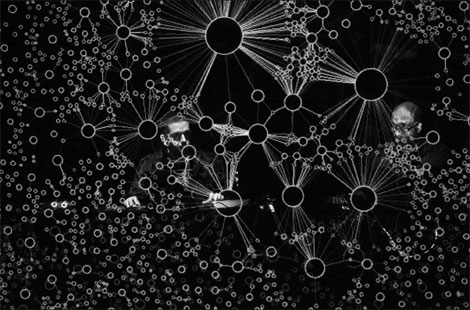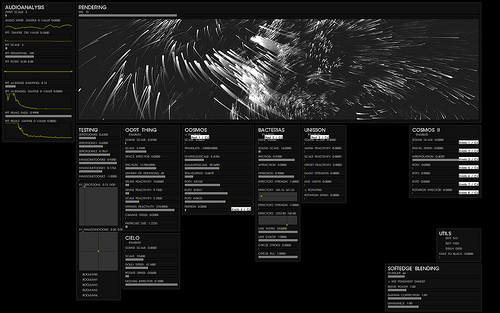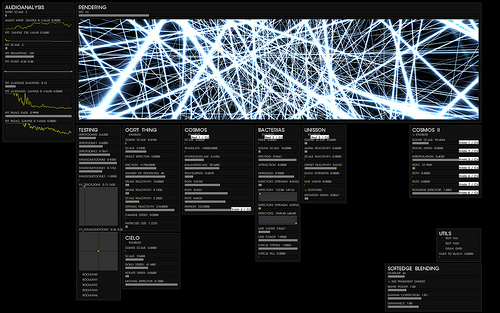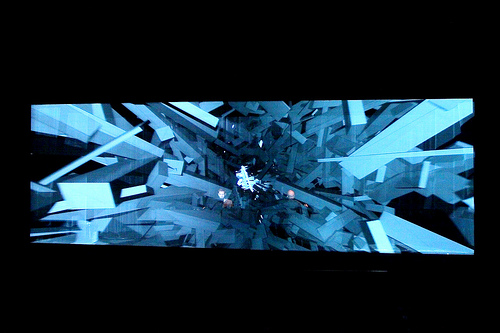Festival
Murcof and AntiVJ‘s Simon Geilfus @ Berlin Atonal
Yesterday we experience one of the most immersive experience with the collaboration between Mexican electronic composer Murcof and AntiVJ‘s Simon Geilfus at Berlin Atonal. With large, semi-transparent screens, they create a fully immersive environment in which microscopic particles, geometric grids and organic elements are mapped in wondrous 3D perspective to the sound of ambient and droning electronica. As amateurs pics I took with my iphone will not make justice to the show, I have collected some professional pics from this collaboration that already last 4 years (2009).




ReFunct Media #4 @ LEAP, April 13th, 2012
ReFunct Media is a multimedia installation that (re)uses numerous “obsolete” electronic devices (digital and analogue media players and receivers). These devices are hacked, misused and combined into a large and complex chain of elements. To use an ecological analogy they “interact” in different symbiotic relationships such as mutualism, parasitism and commensalism.
Voluntarily complex and unstable, ReFunct Media isn’t proposing answers to the questions raised by e-waste, planned obsolescence and sustainable design strategies. Rather, as an installation it experiments and explores unchallenged possibilities of ‘obsolete’ electronic and digital media technologies and our relationship with technologies and consumption.
LEAP (Lab for Electronic and Arts and Performance) presents ReFunct Media #4, a collaborative project by Benjamin Gaulon (IE/FR), Niklas Roy (DE), Karl Klomp (NL), Tom Verbruggen (NL) and Gijs Gieskes (NL).
In the slide show: Trash with attitude (object, in the slide show correspond to the picture that contains a display and machine with word FUCK YOU lighted-on) and Electronic Instant Camera (combination of analogue B&W videocamera and thermal receipt printer, pics from people in the opening located in the wall) by Niklas Roy, Crackle Canvas by Tom Verbruggen (it is a painting that produces sounds: circuitboards, speaker, knobs, switches, wood and canvas), Hypnotoad (hardware version of youtube video of Hypnotoad-character from TV series futurama) and GVS1b by Gijs Gieskes (viewfinder used as display and small security camera that films the person operating the GVS1b so it samples themselves) .
Video above: ReFunct media v4 exhibition-installation. The video is a walk through the installation.
Corrupt.Movie- B.Gaulon (fragment 25 secs). This single channel video is the collection of uploaded images on corrupt.recyclism.com since 2005. The total lenght of the video is 1h 11min 45 sec and includes 107175 images uploaded by thousands of different people from 2005 to 2011.
The opening exhibition included a live performance from TokTek(NL) and VJ MNK (Karl Klomp (NL)): 2 min excerpt in the video above.
Exhibition 14.04.-04.05.2012
Benjamin Gaulon is a researcher, artist and has a broad experience of acting as art consultant, public and conference speaker and art college lecturer. His work focuses on planned obsolescence, consumerism and disposable society. He has previously released work under the name “recyclism”. He is currently leading Data 2.0 (Dublin Art and Technology Association), he co-founded the IMOCA (Irish Museum of Contemporary) Art in 2007 and is lecturer at the National College of Art and Design in Dublin.Since 2005 he has been leading workshops and giving lectures in Europe and US about e-waste and hardware Hacking / Recycling. Workshop participants explore the potential of obsolete technologies in a creative way and find new strategies for e-waste recycling. His research seeks to establish an inter-disciplinary practice and collaborations by creating bridges between art, science and activism, and by doing so, shifting the boundaries between art, engineering and sustainable strategy.
Niklas Roy, born 1974 in Nurnberg, lives in Berlin since 1999 where he initially served as visual effects supervisor in the film industry and later studies Visual Communication at the University of the arts. Since then he has worked successfully as a freelance artist.The core of his work ranges from complex mechanics refined over electronics to purely virtual computer code that manifest themselves in objects, installations and performances.
Karl Klomp (‘79 – NL) is a media artist, vj and theater technician. His research focuses on live audiovisual expressions and interfacing with a fascination for glitch-art, hyper kinetic audio visuals and glitch grabbing. He deals with video circuit bending and hardware interfacing out of obsolete video devices. Together with Tom Verbruggen (Toktek) they play live audio-visual performances (toktek vs mnk).
TokTek (aka Tom Verbruggen) is a Dutch artist who designs and deconstructs his own electronic instruments, giving his music a unique character and allowing him to improvise live on stage with the help of a joystick – the central piece in his live equipment. Behind TokTek stands musician and visual artist Tom Verbruggen, who aside from building his own instruments is an improviser: synths, toys and computer become instruments.His eclectic electronic style has been described as illogical hardware bending, where the outcome creates dramatic live compositions, which break down into delicate and tender sound moments.In one of his incarnations, he performs with VJ MNK (Karl Klomp) – a video artist that hacks/bends video equipment like videomixers.
Gijs Gieskes, an educated industrial designer, he now most enjoys re-appropriating tools for new purposes, making inventive hardware projects; such as his Feedback video log, Strobo VJ machine or PCB hand-painted circuit board. His work and live performances are a fantastic example of where hardware hacking can take you.
‘The King is blind’-100° Berlin-Das 9.Lange Wochenende des Freien Theaters @ Sophiensaele, February 23rd, 2012
Within 100º, the four-day theatre marathon that takes place from 23 until 26 February, Sharon Paz presents The king is blind, 2011, a combination of video and performance, investigating power and control using symbolic images of kings and servants. The performance and video are inspired from shadow theater, using silhouette images of actors placed in two-dimensional environments. The work is inspired by power structures of the past and reflects a critical view on current power structures. Music: Tobias Vethake. Performers: Camilla Milena Fehér, Jürgen Salzmann, Daniela Schulz, Karl-Heinz Stenz. Text source: http://www.sharonpaz.com/index.php?/project/biog/
100º will present more than 130 free productions: Stage versions of Effi Briest, performative concerts with seaman-aesthetics, performances on the topic of work and working-sounds, one-woman-monologues about goulash, virtual live connections to other parts of the world, karaoke singing games and highly acrobatic performances. Once again they have a mix of different aesthetics, contents and formats. Chaos is the concept of 100°.
‘Dark Drives’ exhibition videos part I @ TM – HKW, February 3rd, 2012
Dark Drives. Uneasy energies in technological times – videos – part I. Text source: exhibition catalogue.
Costanza, 2011 – Costanza Candeloro & Luca Libertini: Ever since the practical value of electricity was discovered in the first half of XIX century, close connections between human body and electricity have unfolded multiplicity of trajectories in our culture. Costanza gets in front of the camera touching her body with the tip of a mini jack cable connected to an amplifier. As she moves the cable over different parts of her skin, the current coming from the amplifier connected to the ground through her body and the sound of this electric circuit is heard on the loudspeakers connected to the amp. When she touches her covered parts, no sound is produced. The performance is reminiscent of a peepshow or sex internet video, except she is not striping nor sex, only her body and the electricity connected in a tense act of intimacy.
Armed citizens, 1998-2006. Daniel G. Andujar / Technologies To The People: Originally a website, is a series of images of handguns that can be bought online like the millions of other consumer goods the Internet offers the common user. The images simply present them one after objects of desire mode available by the new economy of digitalised network transactions. Hence, the “armed citizens” the title refers to, are, for whatever reason they buy guns, themselves the products of the commercial logic embedded in the contemporary access culture.
My Generation, 2010, Eva + Franco Mates aka 0100101110101101.org: If you were a teenage boy, what would you do if your mother cancelled your World of Warcraft account? screen like a pig, take off all your clothes, hit yourself with a shoe…? With material found online social platforms such youtube, Eva+Franco Mates demonstrates that computer games are far from mere recreational entertainment. They are extremely addictive and the games industry is fully aware of this. Gamers get hooked on the ‘high’ of the experience, but as any drug-infused high it is also destined to take control and produce effects such as frustration and rage…
Realigning My Thoughts On Jasper Johns, 2011, JK Keller: this is a glitch version of The Simpsons episode “Mom and Pop Art” (Season 10, Episode 19) in which the pop artist Jasper Johns appears as himself. Recalling Johns’ series of ecaustic collages begun in the 50s, Keller handles The Simpsons as mass-produced pop cultural object and distorts image and sound through the misappropiation of standardised software tools. The use Illustrator tool “Allignment abd Distribution” to process the video gives the name to the piece.
‘Dark Drives’ exhibition pics @ TM – HKW, February 3rd, 2012
Dark Drives. Uneasy energies in technological times is the transmediale exhibition in which the main point is to engage with the multiple instances where uneasy energies and the in/compatible, connect and generate processes that challenge consensual and standardized perceptions of technology.
“Uneasy energies in technological times” through an extensive and diverse group of examples claims that distortions, ambiguities, irritations, ironies, and unrest constitute as a significant trajectory in our relations with modern technology and have done so since the use value of electricity was discovered.
The exhibition claims that uneasy energies are insuperable, an integral and constitutive part of technological times. The exhibition is curated by Jacob Lillemose. Text source: http://www.transmediale.de/festival/exhibition
The sequence of pics shows the works in the exhibition, prior the title and after the piece, where it is found two subsequent titles is due to the fact that organization did not allow to film or photograph the next pieces: Dullaart’s video Re: Deep Water Horizon, Chris Burden’c photo+text Doorway to Heaven, Wellmer’s video Error 502… and Dahl, Peill, Zimmer video Web Warriors. Also Borroughs & Balch film The cut-ups and Ant Farm video Media Burn are not photograph or recorded ’cause it was surrounded by 50 people therefore I could not take a close shot.
Manuel Göttsching & Joshua Light Show @ Tm – HKW, February 4th, 2012
The performance programme of transmediale reflects the relationship between “old” and “new” media. A range of works will be presented which use digital “listening devices” to analogue media and thereby lure out the “ghosts in the machine” that gives name to this performances programm.
Joshua Light Show perform in a setting which combines analogue with modern digital projection techniques. As a special highlight, JLS featuring Manuel Göttsching (Ash Ra Tempel/Ashra, de), know as Krautrock / cosmic / minimalism giant, will be bringing together analogue and digital sound-production, and featuring exponents of so-called hauntology and hypnagogic pop.
Manuel Göttsching’s (de) carrier spans over 40 years. First known in the early 1970s as a founder of the German cosmic rockers Ash Ra Tempel – later known as Ashra – Göttsching earned a reputation with his usually atmospheric and subtle guitar work. After a number of albums throughout the 70s, Göttsching’s most decisive and enduring work was released in 1984: E2-E4, a masterpiece of economy. Its hypnotic, treated synth and drum machine loop morphs and unfolds gradually over the entire first side of the album without ever loosing focus – before side two continues with Göttsching’s unique guitar-playing, which unpretentiously blends into the soundscape. With its stringent funkiness and minimalist sonic precision, it became a touchstone for much of the electronic dance music that would later emerge from Germany and internationally. Göttsching has remained active throughout the years while maintaining his position as grand seigneur of Krautrock, cosmic and minimal music.
Text source: http://www.transmediale.de/content/joshua-light-show-ft-manuel-göttsching
Zodiak revisted V featuring Qluster @ Club Transmediale – HAU 2, February 1st, 2012
The Zodiak Free Arts Lab was legendary music and performance space, opened in 1967 by Conrad Schnitzler, Hans-Joachim Roedelius and Boris Schaak. It was located in the ground floor of the actual HAU 2 (Hebbel Am Ufer) and remained active till the end of 1969.
A novel platform with an open-door policy and a serene disregard of filters such as “education”, “skill” and “virtuosity”, The Zodiak served to incubate and launch the musical careers of Kluster (trio composed by 2 of The Zodiak’s founders: Schintzler & Roedelius plus Dieter Moebius), Ash-Ra Tempel, Tangerine Dream, … as well as other projects of the “Berlin School” closely related to krautrock.
“Qluster” (whose video is attached below) is a new formation to follow “Cluster”: its two main members Joachim Roedelius and Onnen Bock will continue to work under the concept of improvised music with electro-acoustic sound sources that in 1969 started with “Kluster”. Text source: http://www.ctm-festival.de/ctm-festival/specials/zodiak-revisited.html
History of krautrock
The 1968 German & Italian student movement, French protests had created a class of young, intellectual continental listeners, while nuclear weapons, pollution and war inspired protests and activism. Avant-garde music had taken a turn towards the electronic in the mid-1950s. Minimalist music emerged in the beginning of the 60s with the works of Americans La Monte Young, Terry Riley and Steve Reich using drones and loops (often with synthesizers and tapes) in a kind of psychedelic and space-oriented music.
The key component characterizing the groups gathered under the term is the synthesis of rock and roll rhythm and energy with a decided will to distance themselves from specifically American blues origins, but to draw on German or other sources instead.
These factors all laid the scene for the explosion in what came to be termed krautrock. Like their American, British and international counterparts, German rock musicians played a kind of psychedelic music, however, there was no attempt to reproduce the effects of drugs, but rather an innovative fusion of psychedelia with jazz, free-jazz and the electronic avant-garde. The next few years saw a wave of pioneering groups. In 1968, Can formed by two former students of experimental classical music composer, Karlheinz Stockhausen added jazz to the mix. The following year saw Kluster (later Cluster) begin recording keyboard-based electronic instrumental music with an emphasis on static drones. In 1970, Popol Vuh became the first krautrock group to use an electronic synthesizer, to create what would be known as “kosmische musik”. By 1971, the bands Tangerine Dream and Faust began to use electronic synthesizers, tape manipulation and advanced production. The bands Tangerine Dream, Ash Ra Tempel, Sand and Cosmic Jokers, all linked by collaboration with Klaus Schulze, would follow suit in the years to come.
Bands such as these were reacting against the post-WWII cultural vacuum in Germany and tending to reject Anglo-American popular culture in favour of creating their own more radical and experimental new German culture and identity, and to develop a radically new musical aesthetic.
In 1972, two albums incorporated European rock and electronic psychedelia with Asian sounds: Popol Vuh and Deuter. Meanwhile, kosmische musik saw the release of two double albums, Klaus Schulze’s Cyborg and Tangerine Dream’s Zeit , while a band called Neu! began to play highly rhythmic music. By the middle of the decade, one of the best-known German bands, Kraftwerk, had released albums like Autobahn and Radioaktivität , which laid the foundation for the British 1980s synthpop/new wave music, electro, techno and other styles later in the century.
By the mid-late 70s onward the terms electronic rock, electronic music, new instrumental music and new age have been used more often than Krautrock and Kosmische Musik. A common rhythm featured in the music was a steady 4/4 beat, base of all actual electronic music.
Text source: http://www.scaruffi.com/history/german.html
CTM – Festival for Adventurous Music and Related Arts @ HAU 2, February 1st, 2012
Club Transmediale (CTM) presents projects that experiment with new aesthetic parameters and new forms of cooperation, develop possibilities for informational and economic self-determination, and reflect on the role of contemporary music against the backdrop of technological and social transformations. Now more than ever, music emerges as a laboratory for multiform experiments and as an active agent that allows for new cultural techniques to be tested and proffered to the wider world. CTM puts the focus on direct experience, risk-taking and personal interaction, and thereby emphasizes the situational potential of live performance, the interplay of various media – sound and image, in particular – and candid exchange between sub-cultural and academic initiatives.
Pictures from Zodiak revisited V shows: first Köhn (BE) followed by Qluster (DE)
CTM is a international festival dedicated to contemporary electronic, digital and experimental music, as well as the diverse range of artistic activities in the context of sound and club culture. Since 1999 it takes place concurrently and cooperatively with the transmediale in Berlin.Joshua Light Show @ Transmediale – HKW, January 31st, 2012
In 1967, as the idea of synesthesia between music and light was becoming part of the culture, Joshua White founded the Joshua Light Show. JLS was a group of artists who performed together, improvising multi-media projections in live concert venues. While much of their work was created for classical music and jazz, a major turning point came with the opening of Bill Graham´s Fillmore East in the spring of 1968. The Joshua Light Show were resident artists at Fillmore East and performed live behind all the major musical artists of the time: Frank Zappa, Janis Joplin, The Grateful Dead, The Doors, The Who, Jefferson Airplane, and Jimi Hendrix. During this same period, JLS toured Europe and created the legendary party scene for John Schlesinger’s Midnight Cowboy.
The video below shows a piece of 1 minute of White’s vintage-light show, first time presented in Germany.
In recent years, the Joshua Light Show has received renewed attention in the art world as White collaborated with artist Gary Panter to recreate aspects of his legendary light shows at The Anthology Film Archives (2004) and with the artist Bec Stupac at The Kitchen, both in New York (2007). Since then, the Joshua Light Show has featured in many exhibitions in the USA and UK.
Text source: http://joshualightshow.com/about_joshua.html